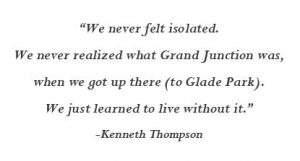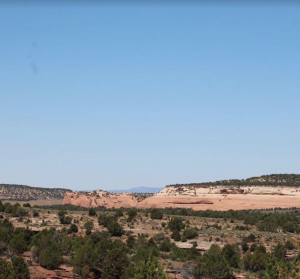He crawled in an occupied bear den for fun, cared for thousands of sheep, and helped build Rim Rock Drive on the Colorado National Monument. This week’s early Mesa County settler spotlight is on Kenneth Thompson! Kenneth saw a great deal during his days of early Mesa County living, all spoken upon during his 1977 Mesa County Oral History Project interview.
 Born in 1908, he moved to the peacefully secluded land of Glade Park in 1917 at the age of nine with his family to start anew, farming and living off the land. Kenneth described the first few years of his life on Glade Park as rough. His father passed in 1919 and left himself and his older brother to tend to the responsibilities of the homestead. The two boys hand-pulled massive amounts of sagebrush from their land and planted Bumblebee Corn, a shorter variety of corn with husks described as “little nubbins”. They grew enough corn to raise and feed pigs and help provide food for horses throughout the winter.
Born in 1908, he moved to the peacefully secluded land of Glade Park in 1917 at the age of nine with his family to start anew, farming and living off the land. Kenneth described the first few years of his life on Glade Park as rough. His father passed in 1919 and left himself and his older brother to tend to the responsibilities of the homestead. The two boys hand-pulled massive amounts of sagebrush from their land and planted Bumblebee Corn, a shorter variety of corn with husks described as “little nubbins”. They grew enough corn to raise and feed pigs and help provide food for horses throughout the winter.
Kenneth initially attended the Glade Park School, north of the Glade Park Store across from a big wash. It was a tiny school with bare essentials, like most schoolhouses in the early 1900s. This school was soon after replaced with the Pipeline School, which exists just north of the Glade Park Store (today it acts as the Glade Park Church and Community Center). He remembers social events referred to as “literaries” held at the churches and schools in the area. During literaries the townsfolk would gather and make up stories for entertainment.
When Kenneth turned a spirited young age of 14, he was “put out” on a sheep camp to herd the flocks. He lived as a sheepherder for nine or ten years, and spoke of a time when he had up to 1,000 head of sheep under his watchful eye.
The sheepherding gig instilled within Kenneth a hardworking mentality, for in his 20’s he took a job working with the Conservation Civilian Corps on the Colorado National Monument building Rim Rock Drive. He drove trucks (a Diamond T and a Model A) and worked breaking up, loading, and dumping rocks to create space for the roadway. He was stationed at two camps, one down at the bottom of the Monument in Fruita and one on top where the National Park Service Visitor Center is located today. During this time he experienced beautiful scenery, tough work, lousy bosses, harsh weather conditions, and a nasty leg wound that was improperly stitched up at camp with gauze left inside of it, causing a bad infection (ain’t modern medicine great?).

Beautiful, sunny Glade Park. Photo source: Ike Rakiecki.
During the majority of Kenneth’s interview with the Mesa County Oral History Project, he slowly and articulately explains what day to day life was like on Glade Park growing up. His family would only take the arduous three-day journey to Grand Junction, Colorado two or three times a year by horse and buggy. They traveled on a burdensome dirt dugway, now the nicely paved Little Park Road east of the Glade Park Store. Kenneth’s family bought necessities in bulk such as 100 pounds of sugar and traded grain for sacks of flour from the old Mesa Flour Mill Company on south 7th Street.
Kenneth recalls Glade Park town dances held at Coates Creek School and sometimes outdoors at the head of canyons where bootlegged liquor seemed to always appear and music was provided by French harp, a dishpan, and the violin. They hunted whatever animals resided around the area including bears, which were extremely common and caused a great deal of trouble for sheepherders. One rifle hunting expedition with the original owner of the Glade Park Store, Unk Laurence, involved Kenneth poking his head inside a bear den to investigate. It did not end well for the hibernating bear – Kenneth still had the bear skin hanging on his wall into the late 1970s.
Kenneth, like so many other Mesa County Oral History Project interviewees, has a plethora of stories that will surprise you, impress you, and make you simultaneously yearn for the past.

My cousin and I worked for my uncle Ken for the 1959 summer, breaking out range land And harvesting grain. We stayed up on the ranch only going to Ken’s junction home Wednesday and suffrage church services and getting supplies.
Fond memories of those 3 months, the glade park store and post off run by Louise Hook. I dated her beautiful daughter Linda. I turned 17 that year, retuned to San Diego to graduate in 1960. I visited uncle Ken and aunt Bertie in 1966 or 7 after I got out of the army as a Vietnam vet.
I always wondered what and where I would be if my mother would have agreed to let me stay with my uncle and work on the ranch and apple orchard.
Hi Pete! That sounds like an amazing summer. We always hope that a relative of someone featured in a Local History Blog will come across it and experience some valuable memories and fond nostalgia. Thank you so much for sharing.
Here it is, 2023, and listening to my uncle Ken tell his bear story. Definitely true, I heard it a few times and saw the bear skin when I worked for him in the summer of 1959.
Now 81, all my aunts and uncles have passed. Uncle Ken had the pioneer upbringing and very interesting background and stories. Aunt Bertie was wonderful and I always enjoyed their visits when I lived in San Diego or drove out their way from San Francisco. I hope this project continues.
Rest in Peace, aunt Bertie and uncle Ken
Hi Pete,
I’m happy this blog post has inspired you to look back on positive memories and experiences with your family. Thank you for reading and for this comment!
We are continuing to add transcriptions and data to the Mesa County Oral History Project. My coworker Kristen has written some incredible history blogs in the last few months – please feel free to check them out here!
Thank you for making this oral history available. We were able to share it with Kenneth’s Granddaughter. This was an awesome gift.
Hi Tim, thank you for your kind comment and for reading the library blog! I’m so happy this was able to reach Kenneth’s granddaughter. It was fun to learn and write about his life; He sounded like an amazingly interesting person.
Well wishes, Michele
update: Aunt Bertie was born Varnon, in Pampa Texas, sister to my step-dad, Robert Walton Varnon.